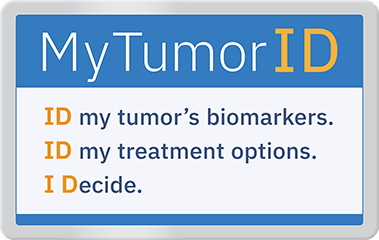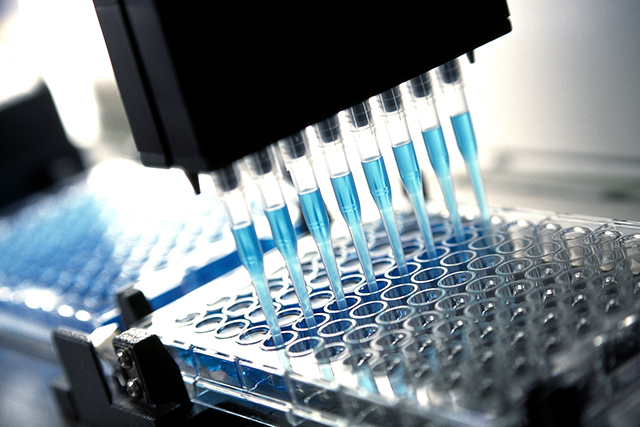When you or a loved one is diagnosed with glioblastoma, it can feel like your world is turned upside down. Suddenly, you’re faced with urgent decisions, unfamiliar medical terms, and a whirlwind of emotions. One piece of information can help bring clarity: the tumor’s biomarkers.
This blog post is part of the MyTumorID campaign, a national effort to empower patients and caregivers through education about biomarker testing and clinical trials. Biomarker testing looks at your tumor on a molecular and genetic level to uncover unique features that may influence how it responds to treatment.
Understanding your tumor’s biomarkers — like its MGMT promoter methylation status — can help you and your medical team make informed decisions about treatment options, including eligible clinical trials.
What is MGMT?
MGMT (short for O-6-methylguanine-DNA methyltransferase) is a gene that acts like a microscopic repair crew. Its job? Fixing damaged DNA inside your cells.
Normally, this is a good thing. But when you have a high-grade brain tumor like glioblastoma, MGMT can work against your treatment. Chemotherapy drugs like temozolomide (TMZ) work by damaging the tumor’s DNA in an effort to stop it from growing.
“Temozolomide and related chemicals deliberately damage the DNA in such a way that it cannot be fixed,” said Craig Horbinski, MD, PhD, Director of Neuropathology at Northwestern Medicine. “It’s actually a sneaky little drug that’s commonly used in gliomas because it doesn’t kill the cell directly. It sort of convinces the cell to kill itself.”
If MGMT is active (unmethylated), it can swoop in and repair that DNA damage to the tumor cells, undoing the work being done by the chemotherapy.
What is methylation?
Methylation is a biochemical process in which a methyl group (one carbon atom and three hydrogen atoms) is added to a molecule, often DNA. This “chemical tag” helps control which genes on the DNA are turned on (“expressed”) or switched off (“silenced”).
What does the MGMT promoter methylation test do?
The MGMT promoter methylation test looks at the tumor cells on a molecular level to determine whether the MGMT gene promoter — a segment that controls whether the MGMT gene is turned on or off — is unmethylated or methylated.
“The MGMT [promoter methylation] test is an extremely important test that every patient who has a brain tumor and needs treatment needs to be tested for to get their MGMT status,” said Yasmeen Rauf, MD, neuro-oncologist at UNC – Chapel Hill.
If the promoter region is unmethylated, the MGMT gene is active, and the tumor is more likely to repair damage from TMZ, making the drug less effective.
Imagine chemotherapy creates DNA damage that the tumor needs a step-by-step recipe to fix. If the MGMT gene promoter is unmethylated, the tumor has the recipe that it can easily follow to fix the DNA damage. But if the gene promoter is methylated, it’s like someone tore out the recipe from the cookbook, so the tumor can’t follow the instructions, and the damage remains.
Did you know?
The MGMT promoter methylation test is different from genomic DNA methylation profiling.
The MGMT promoter methylation test seeks to understand if one gene is silenced, while the genomic DNA methylation profiling helps to classify the tumor against the latest WHO guidelines (helping you understand the type of tumor you have).
“With MGMT methylation testing, we’re talking about focusing on one little promoter on one little gene out of over 12,000 genes in the genome,” Dr. Horbinski said. “Genomic DNA methylation profiling is taking the methylation profile of literally the entire tumor’s genome and using it as a fingerprint to reveal the identity of the tumor for diagnostic purposes in a way that even mutation screening and microscopic analysis sometimes can’t pick up.”
How does MGMT status impact my response to treatment?
MGMT status helps doctors predict how well a patient may respond to temozolomide, the standard chemotherapy for glioblastoma. Knowing your MGMT status can lead to more informed treatment decisions.
Methylated MGMT promoter: Gene is turned off → tumor can’t repair DNA damage caused by chemotherapy as well → more likely to respond to temozolomide
Unmethylated MGMT promoter: Gene is turned on → tumor can fix the DNA damage caused by chemotherapy → less likely to respond to temozolomide
“If a tumor has MGMT promoter methylation, it’s going to respond in all likelihood more favorably to temozolomide because the tumor cells can’t muster up the defense that they need otherwise,” Dr. Horbinski said. “If the tumor does not have MGMT promoter methylation, then it means the tumor — like the rest of your normal cells — can read that recipe and make MGMT protein and defend itself against temozolomide. In those cases, temozolomide doesn’t have as much benefit.”
How common is methylation?
The frequency of methylation in brain tumors varies by tumor type. According to Dr. Horbinski, methylation happens in:
- Roughly 40% of glioblastomas
- 85% of IDH-mutant astrocytomas
- Nearly 100% of IDH-mutant oligodendrogliomas
Rarely do diffuse midline gliomas have MGMT promoter methylation.
Keep in mind that some low-grade brain tumors, like pilocytic astrocytoma, are not treated with temozolomide, so the MGMT promoter test is not a helpful tool like it is with high-grade brain tumors.
“Let’s say somebody has a low-grade tumor,” Dr. Horbinski said. “They’re probably still going to get the MGMT testing because I think it’s just done on everything now. Just because an MGMT promoter test comes back as negative or unmethylated, it doesn’t automatically mean an unfavorable prognosis or response to therapy, because not everybody has temozolomide [as their standard of care].”
My pathology report lists a percentage. What does that mean?
Not every tumor is completely methylated or unmethylated. Some have a mixed result reported as a percentage.
Past research has helped develop cut-off guidelines to indicate at what percentage of MGMT methylation doctors tend to see a good response to temozolomide.
If my tumor is unmethylated, should I take temozolomide?
Patients with unmethylated MGMT tend to benefit less from temozolomide, and the drug, with continued use, can cause side effects like bone marrow suppression, when “your bone marrow doesn’t make enough blood cells or platelets,” according to the Cleveland Clinic. As a result, doctors may consider other options, especially for older or more medically fragile patients.
“There are cases where patients will still receive temozolomide,” said Dr. Horbinski. “There’s no hard and fast answer as to whether an unmethylated tumor should or should not be treated [with temozolomide], especially if it’s one of these borderline cases where, you know, the percentage cut off is kind of just under what we call positive or negative. It’s the art of medicine.”
Treating physicians will consider the following questions to make a determination for the individual patient:
- What is the age of the patient?
- What’s the overall status of the patient?
- How well are they doing otherwise?
- Are they eligible for other clinical trials?
“There are a lot of clinical trials that are specifically designed for patients who do not have MGMT promoter methylation because those are considered the highest priority to come up with a new therapy, because we don’t have a lot of other options,” Dr. Horbinski said. “We can give them radiation, and that’s pretty much it.”
How does MGMT status factor into clinical trial eligibility?
MGMT status plays a key role in clinical trial design and in determining whether certain trials might be a good fit for you. Many trials require MGMT testing upfront, and some are specifically designed for either methylated or unmethylated tumors. That’s because different MGMT statuses respond differently to standard treatments like temozolomide, and researchers want to see how a new drug performs in comparison.
“MGMT status is a routine part of the workup for most clinical trials,” said Dr. Horbinski. “At the very least, what they’re going to try to do is, on a statistical basis, randomize so that equal numbers of methylated and non-methylated [or unmethylated] patients are present in the treated group and the placebo control group because they don’t want that MGMT methylation status to become a confounding variable.”
If one group has significantly more patients with methylated tumors, that could skew the results and make it hard to know whether a new treatment really works.
Some trials are testing drugs aimed specifically at MGMT-methylated tumors, while others focus on unmethylated tumors, where standard treatments are less effective.
“Whenever trials distinguish between the two groups, there’s a reason they’re doing that,” Dr. Rauf said.
Bottom line? Knowing your MGMT status can clarify your clinical trial options and ensure you’re matched to studies designed with your tumor’s biology in mind.
Is MGMT status included in the main pathology report?
MGMT status is not always included right away in the main pathology report. After brain tumor surgery or biopsy, your care team receives a pathology report that states the initial diagnosis. However, that initial report may not include biomarker information like MGMT status.
That’s why MGMT results are typically reported separately or added later as an addendum to the original pathology report. If tumor tissue was sent out, your report might include a note saying something like “Molecular testing for MGMT has been sent out.”
Once the results are in, your care team should receive a revised, expanded, or separate report summarizing key molecular features of the tumor. That’s where you’ll find your MGMT status, along with any other biomarker results that could help guide treatment decisions. It’s then that the pathologist will issue a finalized, integrated diagnosis.
How do I know if my tumor has been tested for its MGMT status?
If you haven’t seen your MGMT status on a report or aren’t sure if it was tested, ask your doctor. You can also request a copy of your full pathology and biomarker testing (molecular) report.
If your treating physician has not sent your tumor tissue out for biomarker testing, ask them to send it off for screening if they can’t do it onsite. Some community hospitals do not have the equipment or infrastructure to perform biomarker testing onsite, but they can send it out to a CLIA-certified laboratory for further testing. CLIA stands for Clinical Laboratory Improvement Amendments, which are federal standards that ensure lab tests are accurate, reliable, and delivered in a timely manner.





